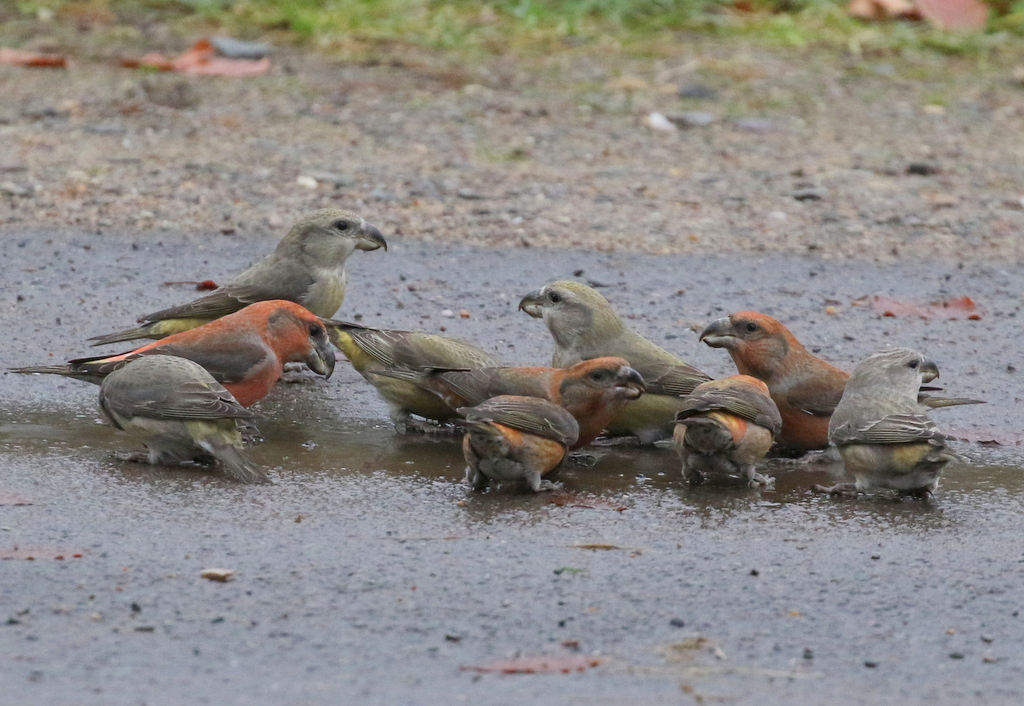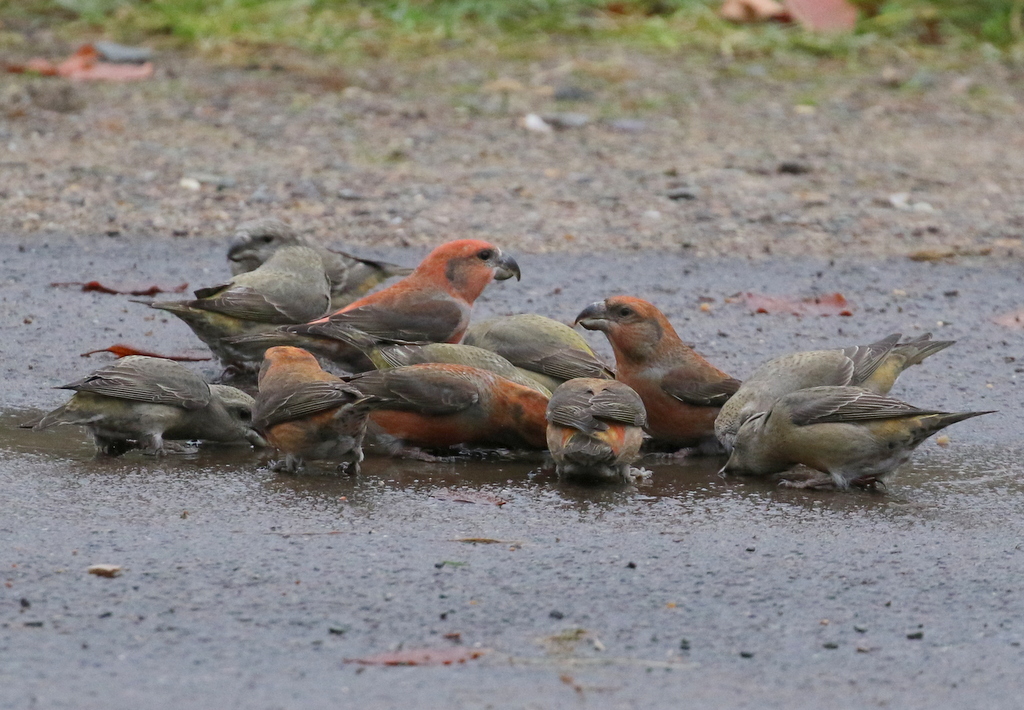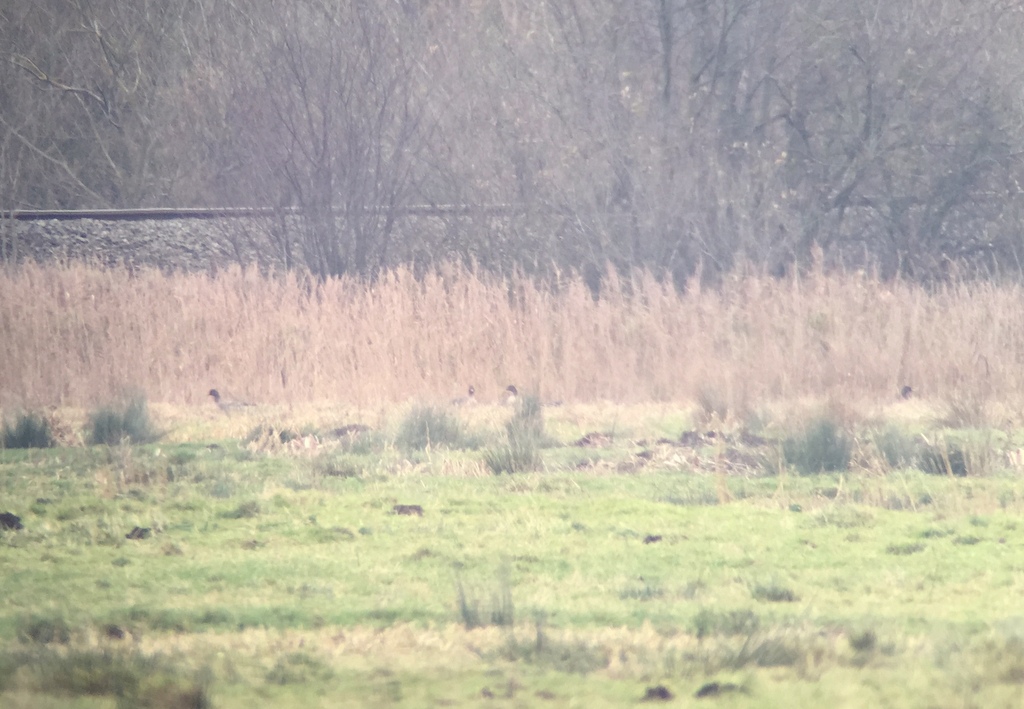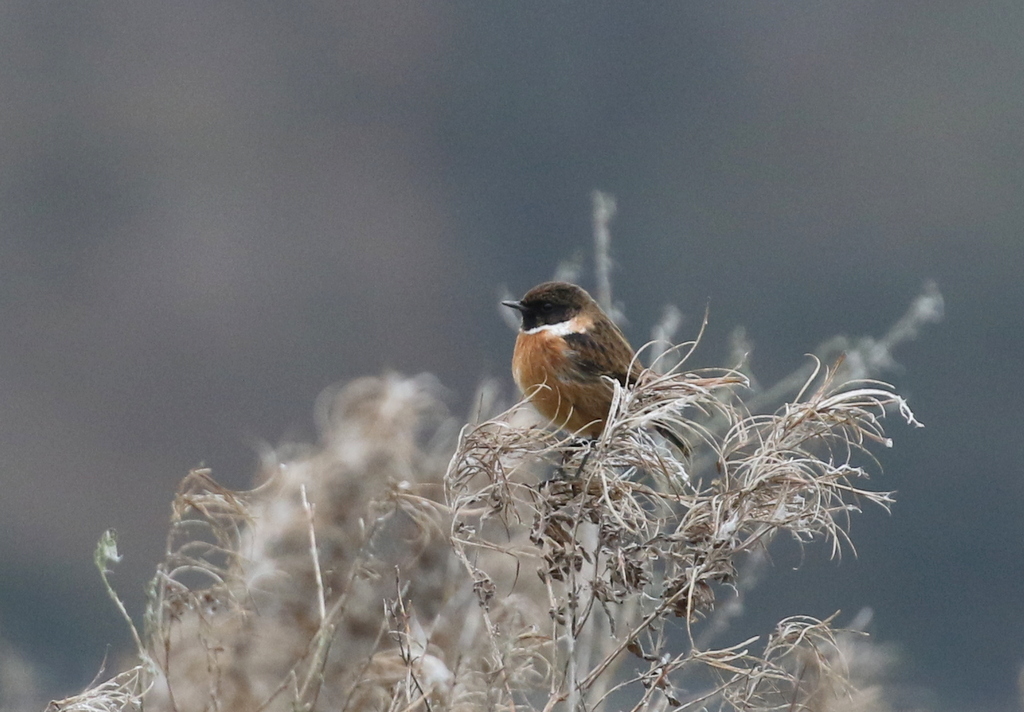A Private Tour across two days, this was not a standard tour but we had a specific list of birds we wanted to see. December can be a very good month to go looking for some of our scarcer wintering species. We were blessed with good weather too – a bit dull under the blanket of cloud, but dry and rather mild for the time of year.
Tuesday 5th December
Our first destination was down in the Brecks at Santon Downham. We wanted to catch up with the Parrot Crossbills which have been here for a couple of weeks now. They were initially to be found around the picnic site at St Helen’s, but have started to wander more widely into the forest now, where they can be much harder to locate. Fortunately, our luck was in today. As we drove into the car park we could see a cluster of long lenses by the side of the road, pointing up into a small clump of trees.
As we got out of the car in the car park, we could hear Parrots Crossbills calling – they have a deeper and less sharp call, more of a ‘peek, peek’ than the familiar ‘glip, glip’ of Common Crossbills. We looked across and could see one or two perched in the top of the beech tree in the corner of the car park by the road.
There seemed to be more Parrot Crossbills – and better light – on the other side of the trees, where all the cameras were focused, so we started to make our way round. Just at that moment, the Parrot Crossbills started to drop down to a tiny puddle in the road, right in front of the assembled photographers (though it took them a while to notice!). We were a little further away, but still only about 10 metres from them. Stunning!
 Parrot Crossbills – coming down to drink at the puddle in front of us
Parrot Crossbills – coming down to drink at the puddle in front of us
We had a great view of the Parrot Crossbills while they were drinking. A couple of times they spooked, for no apparent reason, and flew back up into the trees but quickly returned to the puddle again. It was amazing how many could pack themselves into the tiny area of water! We could see their deep, heavy bills, much bigger than a Common Crossbill’s, and their big heads with thick necks. Parrot Crossbills use their large bills and cheek muscles to prise open the tightest of pine cones to get at the seeds.

 Parrot Crossbills – amazing how many could fit into a tiny puddle!
Parrot Crossbills – amazing how many could fit into a tiny puddle!
There were a variety of different colours amongst the Parrot Crossbills. The more obvious males were red or orange, some of the latter with a scattering of golden yellow feathers. The females were grey-green, with a brighter yellow-green rump. There seem to be a high proportion of young birds in this group, 1st winters, with a varying number of pale tipped greater coverts forming a pale bar across the wing.
After dropping down to drink several times, the Parrot Crossbills flew up into one of the beech trees and sat around preening and calling. One or two of them started to pick at the beech nut capsules, trying to extract the seeds. Then most of them flew and landed in some pine trees in the middle of the car park where we could watch them doing what they do best, snipping of the pine cones and then taking them to a convenient branch where they could methodically work their way round them prising open the scales and extracting the seeds.
Having succeeded with our first target so quickly, we now had time on our side. We decided to head straight on to the Broads to look for the next bird on the list – Taiga Bean Goose. After the long drive across to Buckenham Marshes, we parked in the car park and headed out along the track. A Marsh Harrier drifted across the grazing marshes, flushing all the Rooks from down in the grass.
A short way down the track, we stopped to scan the grazing marshes, particularly looking out towards the corner by the railway which the Taiga Bean Geese usually favour when they are here. There was no sign of them, although they do have a remarkable ability for such a large bird to hide in the dips in the ground. There was a big flock of Canada Geese and a small group of feral Barnacle Geese further over towards the river. A pair of Pink-footed Geese flew in calling and landed out on the grass in the distance.
At that point, we received a message to say that the Taiga Bean Geese had not been seen at either Buckenham or nearby Cantley so far this morning. They had done something similar yesterday, only appearing later in the day, and we had plenty of time on our hands, so we were not completely discouraged. We walked a bit further and stopped to scan for the geese again, on the off chance that they had reappeared and were just hiding. A smart adult Peregrine flew across and landed on one of the gates out in the middle.
 Peregrine – landed on one of the gates in the middle of the grazing marsh
Peregrine – landed on one of the gates in the middle of the grazing marsh
We decided to walk out to the river, checking for the geese on the way, and hoping they might fly in while we were there. If not, we could always then go somewhere else for a couple of hours and come back for another go later in the day.
Something flushed all the ducks from the pools down by the river – a good number of Wigeon and Teal, plus a few Shoveler with them. They all gradually settled back down again and when we got down to that end of the track, we had a better look at them. There were a few Greylags out here too and another three Pink-footed Geese flew in to join them. But there was still no sign of the Taiga Bean Geese hiding out on the grazing marshes the other side.
 Wigeon – there were several hundred on the marshes by the river
Wigeon – there were several hundred on the marshes by the river
A couple of Dunlin were still left on a muddy island on one of the pools and the Lapwing which had also been disturbed gradually started to settle down around them. Two Ruff flew in across the grazing marshes and dropped down out of view. We had a quick look out across the river, then turned to head back. We heard a Water Pipit call earlier, on the way out, but hadn’t seen it, and at that moment either it or another Water Pipit flew over our heads calling and disappeared off towards Strumpshaw.
We stopped to scan the grazing marshes again, as we had done several times on the way out, but this time we noticed a line of geese had appeared while we had been looking out across the river, right over the far side, against the reeds. Where they were, they could only really be one thing and, setting up the scope quickly, we confirmed they were the Taiga Bean Geese. We could see their rather wedge-shaped heads and long bills, and as they turned and caught the light, we could see the quite extensive patches of orange on their bills.
 Taiga Bean Geese – at the far side of the grazing marsh, against the reeds
Taiga Bean Geese – at the far side of the grazing marsh, against the reeds
A little further back along the track, we were a little bit closer and stopped for another look. We could see at least 13 Taiga Bean Geese, but some were well hidden down on the edge of the ditch, so there were possibly the full 18 which is the maximum which have been reported in the last few days.
Taiga Bean Geese are a declining winter visitor to the UK. They have particular habitat requirements and only winter regularly at two sites – here in the Yare Valley in Norfolk or up on the Slamannan plateau in Scotland. The numbers coming here have dropped steadily in recent years, from several hundred in Norfolk in the 1980s and 1990s to just around 20 in the last few years. In milder winters, they have often only stayed for a shorter time, but recently have sometimes departed in early to mid January, having just arrived in late November.
The Taiga Bean Geese will probably take on an increased significance from the start of 2018. When the BOU British List moves to adopt the IOC World Bird List taxonomy from 1st January, Taiga and Tundra Bean Goose will be treated as separate species (they are currently treated as two subspecies of Bean Goose). For those who are interested in ‘ticks’, it will be prudent to come and see the wintering Taiga Bean Geese while you still can!
As we walked back to the car, a pair of Stonechats were feeding along the side of the track, perching up in the tall dead willowherb seedheads. We had enjoyed a remarkably productive morning, with the two of our main target species already under our belts, either of which could easily have taken us much of the day to find.
 Stonechat – perched in some dead willowherb
Stonechat – perched in some dead willowherb
Snow Bunting was the next species on the list, so we headed down to the coast. There are several beaches where you can see flocks of these winter visitors here, but the best option today seemed like the area around Happisburgh and Eccles, where a large group had been seen in recent days. There had also been a Desert Wheatear at Eccles in recent days, but it appeared to have done a bunk overnight – fortunately it was not a target for us today. However, there were a couple of other things of peripheral interest which we could also possibly see in the area.
Cart Gap seemed like the best place to park, so we stopped for lunch there. After we had eaten, we noticed another Norfolk birder returning to his car and went over to ask for an update on what was about. He told us that he had seen the Snow Buntings but they were a good distance south of us, so we got back in the car and drove round closer to Sea Palling.
As we crossed onto the beach, a beach buggy of sorts was being driven north along the sand. We had no idea what it was doing out here, but as it disappeared round the corner of the dunes, we saw a flock of small birds fly up from the beach and land back down again. The Snow Buntings. We walked further up and found them on an area of shingle on the top of the beach. They flew towards us and landed on the sand up by the dunes. We could see a patch of the sand which looked a different colour there and they gathered into a tight group around it, feeding – someone has put seed out for them here.
 Snow Buntings – coming in to seed put out on the beach for them
Snow Buntings – coming in to seed put out on the beach for them
There was a good size flock of Snow Buntings here – probably at least 60 birds in total. They flew off and landed on the stones again, before coming back to the seed. We watched them for a while – there appeared to be a mixture of paler Scandinavian and darker Icelandic birds in the flock. Eventually, they flew up and landed back in the dunes.
It had been cloudy all day, but the sky seemed to have darkened and the light was fading already. We had a quick scan of the beach and out to sea, but couldn’t immediately see anything beyond a few gulls and a single seal just offshore. Rather than try to drive back round to Eccles, in the limited time we had before it was likely to get dark, we decided to walk back up there along the beach. It wasn’t too far and it was nice to have a walk after spending quiet a bit of time in the car today.
We crossed to the track inland of the dunes and stopped briefly by the field where the Desert Wheatear had been. Three Shorelarks had been reported here earlier this morning, but there was no sign of those either now, thankfully also not a target for today, though always nice to see. What we really hoped to see here was the Arctic Redpoll which had been feeding in the edge of a beet field a little further north, so we didn’t linger here.
When we arrived at the beet field, there was no sign of anything feeding in the weeds along the edge and at first the hedge looked empty too. There was a large bush sticking out from the hedge much further down and we could see there were some birds perched on the near side of it. We got them in the scope and could see they were Redpolls, a good start.
There appeared to be a mixture of darker Lesser Redpolls and slightly paler Mealy Redpolls, but one bird in the middle of the bush stood out. It was face on to us, busy preening, but looked much paler, whitish below, paler faced. It turned briefly and puffed itself up and we could see a large pale rump. It was the Arctic Redpoll. Once again we were fortunate, because after watching it for a few minutes, all the Redpolls took off and flew away across the field, presumably heading off to roost.
It was starting to get dark by the time we got back to the car, passing the Snow Buntings again on our way. It had been a very successful day.
Wednesday 6th December
With the pressure off, after all our successes yesterday, there was only one more species on the list of the most likely targets which we really wanted to find today, Lapland Bunting. There have been a few in the clifftop fields at Weybourne for a few weeks now, but they can be very mobile and elusive. We headed over there to see what we could find.
As we walked down the track towards the Coastguards Cottages, we could hear Pink-footed Geese calling. We looked across to see hundreds of them circling over the fields before dropping down out of view to feed on an area of recently cut sugar beet. A Grey Wagtail flew over calling, an odd place to find this species, so possibly a migrant.
When we got to the gate, the stubble field which the Lapland Buntings have been favouring looked quite deserted. Appearances can be deceptive though. We could see some Skylarks flying round and landing in the grass on the clifftop, so we made our way round to that side. Unfortunately, as we walked over the hill, we met a dog walker coming the other way right along the edge of the stubble, just where we had planned to look, flushing all the Skylarks and Meadow Pipits out of the grass as he approached us.
Most of the birds appeared to drop back down into the stubble, down at the bottom of the hill. Then we spotted a flock of Linnets down there too, which flew up, circled round, and dropped back in to the stubble not far in from the grassy edge. That looked the best place to try. Finally, as we walked slowly down the hill, carefully scanning through the Skylarks which flew up from the stubble as we passed, we heard a Lapland Bunting calling, a distinctive dry rattle, followed by a clipped ringing ‘teu’. It didn’t appear to have come up out of the field but flew in from behind us, high overhead, and dropped down into the stubble over where we were headed.
At least we had seen a Lapland Bunting in flight – now finding one out in the middle of the stubble would be a bigger challenge. We continued on down the hill and stood on the grass opposite where it had seemed to land, scanning the field, but we could barely see anything in the vegetation. We needed a break, and after a while we got one. The Linnets took off and whirled round over the field. As they came back in low over the stubble, a Lapland Bunting flew up to join them and this time we could see where it landed.
Even though we had seen roughly where it had landed, it still took us quite a while to find the Lapland Bunting on the ground. We scanned back and forth across the area repeatedly, at first finding nothing but Skylarks and the odd Linnet. Finally it came out of the thick stubble into a slightly more open patch, and we got a good look at it through the scope. It was creeping around like a mouse, head down, not like the much bolder Skylark just behind it. We managed to stay on the Lapland Bunting for several minutes, despite it disappearing in and out of the stubble and furrows at times. Eventually we lost sight of it again and we decided to head back to the car.
Black Redstart was also on the wanted list, but we knew it would be unlikely we could find one at this time of year. There had been the odd one reported in very disparate parts of the coast in recent weeks, but they all seemed to be one day birds, possibly just passing through. As we still had some time available, we thought we might as well give it a go on the off chance. Sheringham can be a good place for them sometimes and, although there had been no reports from there for over two weeks, it seemed worth the long shot – especially as it was not far away.
We had a good look around the Leas, the ornamental garden and the boating lake, round the back of some of the buildings they sometimes favour, but not surprisingly we drew a blank. We decided to have a walk along the prom and a look out to sea. There were a few Red-throated Divers moving offshore and a Guillemot was diving out on the sea. Four Common Scoters flew east.
 Turnstones – feeding on seed put out for them on the Prom
Turnstones – feeding on seed put out for them on the Prom
There were lots of Turnstones along the Prom, with a large group feeding on some seed put out for them by ‘The Tank’. There are usually at least a couple of Purple Sandpipers on the sea defences along here too and just past there we found one, feeding on one of the seaweed encrusted slipways. It flew back towards ‘The Tank’ and we followed it, finding it feeding on the concrete blocks just below the Prom.
We started to make our way back and a second Purple Sandpiper was feeding on the blocks further back. We watched it slipping and sliding on the seaweed as it tried to clamber up and down the faces of the concrete.
 Purple Sandpiper – feeding on the seaweed-encrusted sea defences
Purple Sandpiper – feeding on the seaweed-encrusted sea defences
We had already found all the target species which we had identified as likely possibilities prior to the tour. Rather than enjoy a couple of hours of general birding on our way back along the coast for the rest of the afternoon, looking for some of the other specialities you can find on a winter’s day in North Norfolk, with a long drive ahead, the decision was made to head for home. We called it a day: mission accomplished.
















